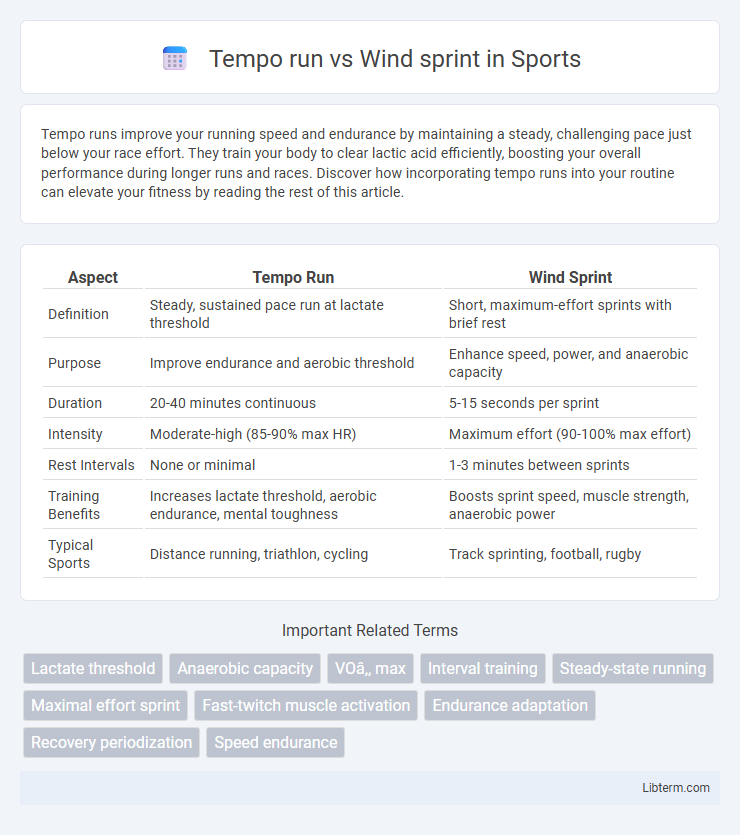Tempo runs improve your running speed and endurance by maintaining a steady, challenging pace just below your race effort. They train your body to clear lactic acid efficiently, boosting your overall performance during longer runs and races. Discover how incorporating tempo runs into your routine can elevate your fitness by reading the rest of this article.
Table of Comparison
| Aspect | Tempo Run | Wind Sprint |
|---|---|---|
| Definition | Steady, sustained pace run at lactate threshold | Short, maximum-effort sprints with brief rest |
| Purpose | Improve endurance and aerobic threshold | Enhance speed, power, and anaerobic capacity |
| Duration | 20-40 minutes continuous | 5-15 seconds per sprint |
| Intensity | Moderate-high (85-90% max HR) | Maximum effort (90-100% max effort) |
| Rest Intervals | None or minimal | 1-3 minutes between sprints |
| Training Benefits | Increases lactate threshold, aerobic endurance, mental toughness | Boosts sprint speed, muscle strength, anaerobic power |
| Typical Sports | Distance running, triathlon, cycling | Track sprinting, football, rugby |
Understanding Tempo Runs: Definition and Purpose
Tempo runs are steady-paced workouts designed to improve lactate threshold by maintaining a comfortably hard effort, usually around 80-90% of maximum heart rate or a pace sustainable for 20-40 minutes. Their purpose is to enhance endurance and running economy by teaching the body to clear lactate efficiently during sustained efforts. Compared to wind sprints, which are short, high-intensity bursts aimed at improving speed and anaerobic capacity, tempo runs target aerobic threshold and stamina development.
What Are Wind Sprints? Key Characteristics
Wind sprints are short, high-intensity bursts of running typically ranging from 20 to 100 meters that aim to improve speed, power, and anaerobic capacity. These sprints involve maximal effort with full recovery periods to ensure quality performance and technique enhancement. Key characteristics include explosive acceleration, brief duration, and emphasis on fast-twitch muscle fiber activation for improved sprinting mechanics.
Physiological Benefits of Tempo Runs
Tempo runs enhance aerobic endurance by increasing lactate threshold, allowing runners to maintain faster paces with less fatigue. These runs improve cardiovascular efficiency, elevating stroke volume and oxygen delivery to muscles during sustained efforts. Consistent tempo training also boosts metabolic adaptations, promoting efficient energy utilization and delaying the onset of muscle acidosis.
Performance Advantages of Wind Sprints
Wind sprints enhance explosive power and improve fast-twitch muscle fiber recruitment, resulting in superior acceleration and top-end speed compared to tempo runs. The high-intensity nature of wind sprints promotes anaerobic capacity and neuromuscular coordination, which directly translate to improved sprinting performance. Unlike tempo runs that emphasize aerobic endurance, wind sprints target maximum effort bursts, optimizing muscle strength and quickness essential for competitive athletics.
Comparing Training Effects: Tempo Run vs Wind Sprint
Tempo runs enhance aerobic capacity and lactate threshold by maintaining a steady, challenging pace that improves endurance performance. Wind sprints primarily develop anaerobic power and neuromuscular coordination through repeated high-intensity bursts, boosting speed and explosive strength. Comparing training effects, tempo runs build sustained cardiovascular efficiency while wind sprints target short-duration, high-intensity muscle activation and recovery speed.
Ideal Workout Frequency: Tempo Runs vs Wind Sprints
Tempo runs are best performed 1 to 3 times per week to enhance aerobic capacity and lactate threshold without overtraining. Wind sprints, characterized by short, intense bursts of speed, should be limited to 2 times per week to promote fast-twitch muscle development and prevent injury. Balancing these workouts optimizes performance by allowing adequate recovery while targeting different energy systems.
Tempo Runs for Endurance Building
Tempo runs enhance endurance by maintaining a challenging but sustainable pace, improving lactate threshold and aerobic capacity. Wind sprints focus on short bursts of maximum effort, targeting speed and power rather than prolonged stamina. Incorporating tempo runs regularly builds a strong aerobic base essential for long-distance performance.
Wind Sprints for Speed Development
Wind sprints are high-intensity intervals that significantly boost speed development by improving fast-twitch muscle fiber recruitment and anaerobic capacity. Unlike tempo runs, which target aerobic endurance through sustained moderate pacing, wind sprints enhance explosive power and maximum velocity. Incorporating wind sprints into training accelerates neuromuscular adaptation, leading to quicker acceleration and top-end speed.
When to Incorporate Each: Training Scenarios
Tempo runs are ideal during base-building phases to enhance aerobic capacity and lactate threshold, making them perfect for sustained efforts in endurance training. Wind sprints are best incorporated in speed and power-focused sessions, typically in the final stages of a training cycle or as part of high-intensity interval training (HIIT) to improve acceleration and neuromuscular function. Coaches often schedule tempo runs mid-week for steady-state conditioning, while wind sprints are reserved for recovery days or pre-race preparation to sharpen sprinting mechanics and explosive strength.
Choosing the Best for Your Running Goals
Tempo runs build aerobic endurance and improve lactate threshold by maintaining a steady, challenging pace just below race speed, ideal for distance runners targeting marathon or half-marathon PRs. Wind sprints enhance anaerobic capacity and speed by incorporating short bursts of maximum effort with full recovery, suitable for sprinters or runners aiming to improve explosive power and fast-twitch muscle fibers. Choosing the best depends on your goals: prioritize tempo runs for sustained speed and endurance or wind sprints for increased acceleration and top-end velocity.
Tempo run Infographic

 libterm.com
libterm.com